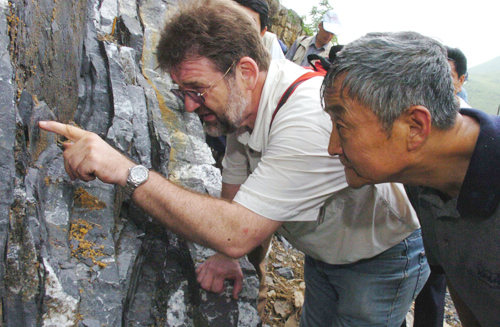|
 |
|
ON SITE INVESTIGATION: A team of 19 foreign and domestic archeologists go deep into remote mountains, searching for fossils relating to the Permian period (YANG JUNJIANG) |
While people are still thrilled by scenes of the destruction of the Earth in the movie 2012, scientists are finding ways to explain the reasons for past extinctions, which can serve as a warning for the human race.
The end-Permian mass extinction, about 252.28 million years ago, was the most severe biodiversity crisis in the Earth's history. The Permian is a geologic period and system which extends from approximately 299 million to 251 million years ago.
A Paleozoic research group led by Shen Shuzhong from Nanjing Institute of Geology and Paleontology (NIGP) found out that in the end-Permian, 80-95 percent of all species on Earth, on land and in the oceans, became extinct within an estimated time interval of less than 200,000 years.
The process was much shorter than the previous judgment, which was 10 million years, made by John Sepkoski in 1984. Sepkoski was a renowned paleontologist of the University of Chicago in the United States.
The research result said the course of environmental deterioration can last for a long time. Once the deterioration accumulates beyond the capacity of the ecosystem, mass extinction can occur quickly in a very short period of time.
The end-Permian extinction is the worst of its kind in the Earth's history. The whole ecosystem collapsed and the biosphere almost went back to its original state. Following that, the Earth entered a 5-million-year slump of biological activity.
The new findings come from 10 years' arduous work by an international research team made up of 14 institutions across the world, including NIGP under the Chinese Academy of Sciences, the University of Science and Technology of China and the Massachusetts Institute of Technology.
The team had more than 20 scientists from across the world and was led by Chinese scientist Shen Shuzhong, a researcher with the NIGP. Their paper, titled "Calibrating the End-Permian Mass Extinction," was published in Science, a top academic magazine.
It was difficult to determine the exact period of the mass extinction. And the reasons for the extinction had long been a mystery, said Shen.
As early as 2000, a group of Chinese scientists led by Jin Yugan, an expert on stratigraphic paleontology and former director of the academic committee of NIGP, published a paper in Science. They theorized the mass extinction was caused by an instantaneous event instead of gradual extinction.
This assumption challenged Darwin's theory of evolution featuring survival of the fittest. But it was echoed by a group of U.S. and Japanese scientists. They said that an asteroid slammed into the Earth and the strong seismic waves instantly killed almost all living creatures. Their opinions were popular for a long time.
To determine the nature of the mass destruction required finding enough fossils, which are the most accurate record of evolution. So Shen led his research team to collect fossils in mountains and remote areas, looking for evidence from hundreds of millions of years ago.
Over the past decade, Shen's team went across China, went to Pakistan and surrounding areas. They conducted high-resolution biostratigraphy into the geological profiles of the Permian-Triassic times in these areas. These geological profiles included the marine environment, terrestrial environment and transitional environment between the two.
Their efforts proved fruitful. In Meishan Mountain in east China's Zhejiang Province, they found a high-resolution tooth-shaped fossil zone. The fossils varied in size, but were all similar rectangles. They were standard fossils that paleontologists use to divide the Paleozoic and the Mesozoic eras.
| 